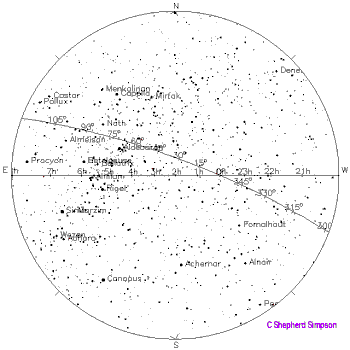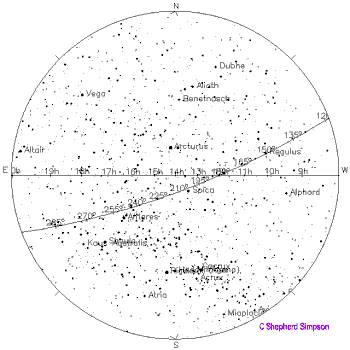Zodiac Charts
|
Definition: [Zodiacs] "Fixed star" charts and zodiac sign charts for the Real Solar Zodiac and the Planetary Zodiac. To the right is a complete zodiac chart showing the Real Solar Zodiac signs [blue] and the Tropical Zodiac divisions of the Ecliptic [red]. Below are eight zodiac charts. The first two feature the 29 [25 Ptolemaic] constellations of the Planetary Zodiac. The Lunar Zodiac also follows 20 of these signs [18 Ptolemaic]. The next two are fixed star charts of the bright stars in the same regions of sky as the planetary zodiac charts. Below these are northern and southern hemisphere zodiac charts showing the sign boundaries of the 13 Real Solar Zodiac constellations. Below these are "fixed" star charts in the same regions of the sky as these solar zodiac charts. Click on any picture to see a larger version. |
![A zodiac sky chart shwowing the real constellation widths [blue] and the tropical zodiac constellation widths [red].](images/realsolarzodiacsmall.gif)
A Complete Zodiac Chart. The chart shows the whole Solar Zodiac. In blue are the actual signs of the Real Solar Zodiac. In red are the Tropical Zodiac 30° divisions of the Ecliptic. There is almost no correspondence between the two. The Tropical Zodiac is inaccurate because of the Movement of the Ages. Unfortunately this is the standard Western zodiac. |
![The section of the zodiac towards the vernal equinox point [0 degrees of the ecliptic].](images/panetaryzodiac180small.gif)
Star chart of the planetary zodiac looking towards the Vernal Equinox point. The curved line is the Ecliptic. The horizontal line is the Celestial Equator. Original Ancient Greek signs are colored blue. |
![The section of the zodiac towards the autumn equinox point [180 degrees of the ecliptic].](images/panetaryzodiac0small.gif)
Star chart of the planetary zodiac looking away from the Vernal Equinox point. The curved line is the Ecliptic. The horizontal line is the Celestial Equator. Original Ancient Greek signs are colored blue. Leo Minor, the Lesser Lion, Sextans the Sextant and Scutum, the Shield, were not constellations recognized by the Greek originators of astrology. Coma Berenices, Berenice's Hair, is not a Ptolemy constellation, though it predates Ptolemy by several centuries and is mentioned by him in Tetrabiblos. |

Real Solar Zodiac chart of the northern sky signs at the Summer solstice [i.e. Summer solstice in the northern hemisphere, Jun 21st]. The arc going from northeast to southwest is the ecliptic. The degrees along the ecliptic from the Vernal Equinox are marked. The order of constellations of the Sun's path, as seen from Earth, is Pisces, Aries, Taurus, Gemini, Cancer, Leo, Virgo. Virgo is a very large sign in comparison to, for example, Gemini. |

Real Solar Zodiac chart of the southern sky signs at the Summer solstice [i.e. Summer solstice in the northern hemisphere, Jun 21st]. The arc going from northwest to southeast is the ecliptic. The degrees along the ecliptic from the Vernal Equinox are marked. The order of constellations of the Sun's path, as seen from Earth, is Virgo, Libra, Scorpius, Ophiuchus, Sagittarius, Capricornus, Aquarius, Pisces. Scorpius is the smallest sign in terms of the extent of the ecliptic it occupies. |

"Fixed star" chart of the southern sky at the Summer solstice [i.e. Summer solstice in the northern hemisphere, Jun 21st]. The arc going from northwest to southeast is the ecliptic. The degrees along the ecliptic from the Vernal Equinox are marked. The stars are shown as black on a white background. Few bright stars lie close to the ecliptic, Spica and Antares being exceptions. This is doubtless why the Vedic Zodiac takes Spica as is starting point. Most bright stars lie along the Milky Way Galaxy, the band of stars running from southwest to northeast across the chart. This is probably why the Ancient Greeks, the Achaeans saw this band of stars as so important in their astrology: the Galactic Zodiac. |

"Fixed star" chart of the northern sky at the Summer solstice [i.e. Summer solstice in the northern hemisphere, Jun 21st]. The arc going from northeast to southwest is the ecliptic. The degrees along the ecliptic from the Vernal Equinox are marked. The stars are shown as black on a white background. Few of the brightest stars in the sky lie close to the ecliptic: Aldeberan, Castor, Pollux and Regulus being the exceptions. This is probably why the Fagan Sidereal Zodiac takes Aldeberan as is starting point. |
The Zodiac and Astrology:
© Dr Shepherd Simpson, Astrological Historian
Historical Astrology
See the new Astrological Index for the meaning of other astrological words and phrases

